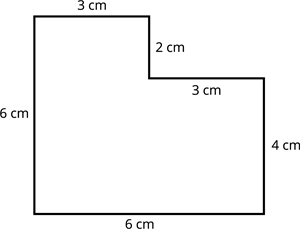
PUMPA - SMART LEARNING
எங்கள் ஆசிரியர்களுடன் 1-ஆன்-1 ஆலோசனை நேரத்தைப் பெறுங்கள். டாப்பர் ஆவதற்கு நாங்கள் பயிற்சி அளிப்போம்
Book Free DemoSo far, we have learnt how to find the perimeter and area of the shapes and combined shapes by applying the formula.
Let us learn how to find the perimeter and area of the shape after removing a portion from a given shape with an example.
Example:
Let us consider an example to understand the concept.
Consider a square whose side length is 6 cm. Let us find the area and perimeter of the square.
Area, A=s \times s
A=6 \times 6
A=36 sq. cm
Perimeter, P=4s
P=4\times 6
P=24 cm
Now, let us cut a rectangle of length 3 \ cm and breadth 2 \ cm from the corner of the square and find the perimeter and area of the given shape.

Solution:
Given:
The side length of the square =6 \ cm.
The length of the rectangle =3 \ cm.
The breadth of the rectangle =2 cm.
To find the perimeter and area of the square after removing the rectangle.
Perimeter of the given shape = Sum of all measures of outer length
Perimeter = (3+6+6+4+3+2) cm
Perimeter =24 cm
Therefore, the perimeter of the given shape is 24 cm.
Area of the given shape = Area of square - Area of rectangle
Area of the given shape = s \times s - l \times b
= 6 \times 6 - 3 \times 2 sq. \ cm
= 36-6 sq. cm
=30 sq. cm
Therefore, the area of the given shape is 30 sq. \ cm.
Here, the perimeter is not changed, but the area is decreased.
Hence, removing a portion from a given shape results in the area to be decreased.